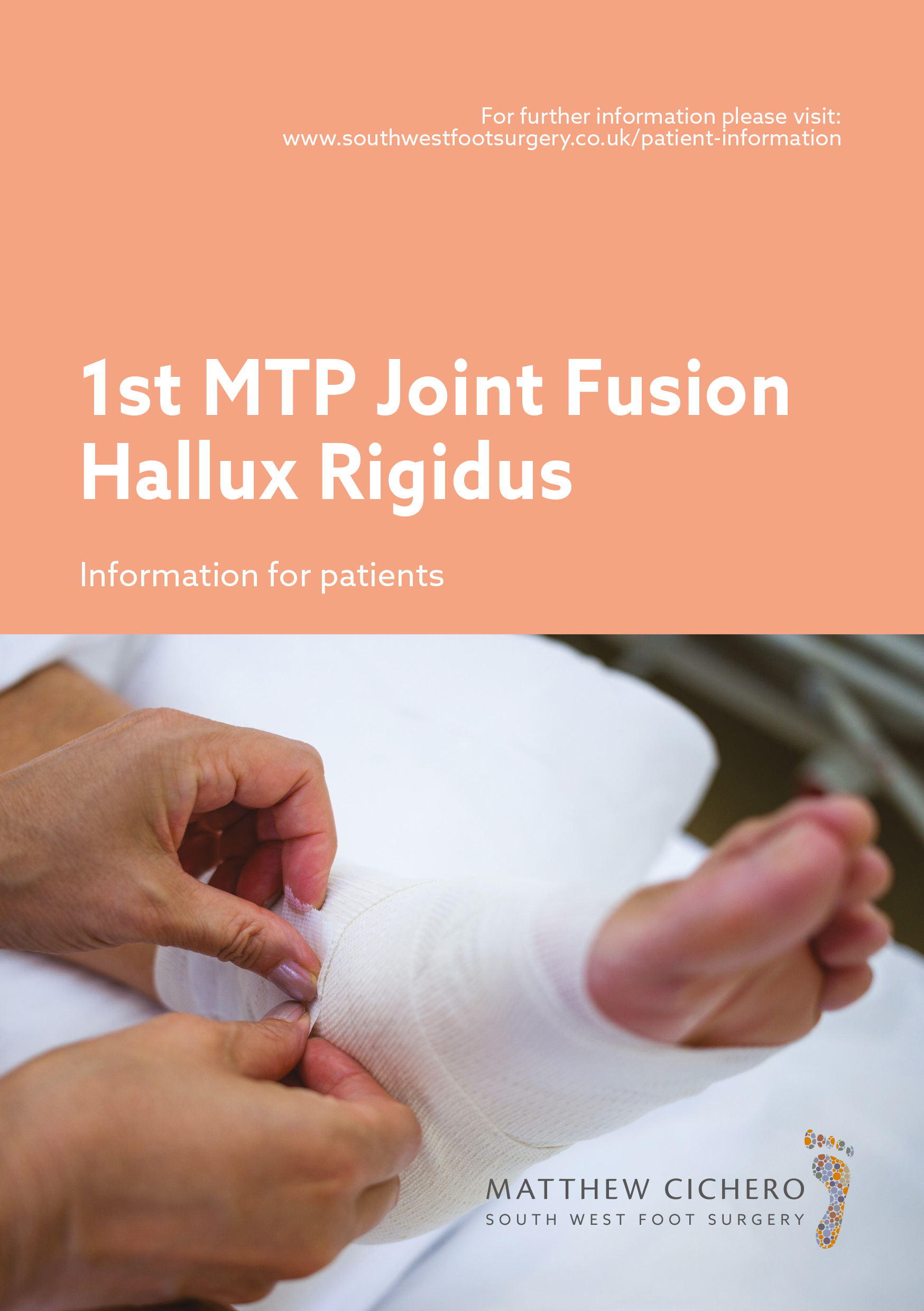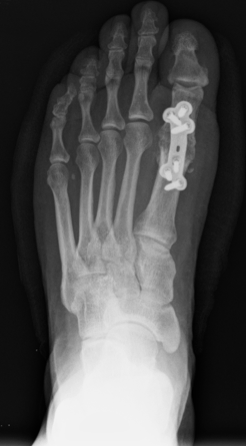1st MTP Joint Fusion
(Hallux Rigidus)
Procedure
1st MTP Joint Arthroplasty or Fusion. Soft tissue release.
Aims of surgery
To reduce pain and deformity.
To improve the big toe alignment (make straighter).
Advantages of this operation
Reduces pain by removing any movement in the joint.
As a result, the outcome of the procedure is more predictable.
Definitive procedure
Specific risks of this operation
Pressure lesion to the big toe.
Arthritis of the small joint in the big toe.
Poor alignment.
Nerve/tendon/blood vessel damage.
Deep Vein Thrombosis/Pulmonary Embolism.
Delayed or Non-union of bone (bone does not knit together).
Problems with xation (the screws/plates).
Transfer of pressure to the ball of the foot.
Further surgery.
Operation time
Usually between 45 to 60 minutes.
Incision placement/stitches are usually on the top of the toe and with absorbable stitches where possible.
Indications for the Procedure
Painful, unstable or arthritic 1st metatarsophalangeal joint.
Difficulty with shoe t despite wearing sensible footwear.
Failure of alternative treatment, e.g. orthotics/injections.
Procedure
The bony surfaces on either side of the big toe joint are debrided to remove the worn-out cartilage. The raw bone surfaces are then held together whilst they fuse (heal together).
Fixation
Internal fixation (bone screws, plates or wires) are used to hold the bone together. You will not notice these and they do not usually need to be removed (<20%).
Will I have plaster?
No, you will be provided with a special shoe to wear following the surgery.
Is this a Day Procedure?
Yes, you can usually go home the same day.
Estimated time off work
Non-manual work approximately 4 weeks.
Manual work 5–6 weeks.
Alternative treatments
Manage your symptoms by altering activity levels, using painkillers and anti-inflammatories, extra depth/width shoes, rocker sole (stiff curved sole) using an insole or orthotic foot support, joint injection therapy. Other surgical options include 1st MTP joint excisional arthroplasty or joint implant.
More information
Speak with your consultant.
The operation can be performed comfortably under a local anaesthetic block, which is achieved by either a series of injections around the ankle, or an injection behind your knee. You will be fully awake during the operation and will be able to feel touch, pressure and vibration, but you will not feel any pain. If you do not wish to consider having the operation performed whilst still awake, or your Consultant does not feel this is the best option for you, you will be offered local anaesthetic with sedation or general anaesthesia.
Post-Operative Care
First 2-4 days
This is the time you are likely to have the most pain, but you will be given painkillers to help. You must rest completely for 2–4 days.
You will be able to stand and take weight carefully on your other foot after the operation, but you must rest, with your feet up, as much as possible.
You should restrict your walking to going to the bathroom. When getting about, use your post op shoe in the way you will have been shown.
You can get about a little more after 3 days.
1 week after surgery
You may need to attend for your foot to be checked and redressed.
You may start to do a little more within your pain limits. An increase in pain can mean you are doing too much.
2 weeks after surgery
You may need to attend again. Sutures will be removed if necessary.
Between 3–5 weeks after surgery you will need to attend for a review and x-rays.
If the fusion site is healed, you will be advised to wear trainer type shoes and begin to walk fully.
The foot will still be quite swollen especially at the end of the day.
You may return to work but may need longer if you have an active job.
You may return to driving if you can perform an emergency stop. You must check with your insurance company and Mr. Cichero before driving again.
Between 8–12 weeks after surgery
The foot should continue to improve and begin to feel normal again.
There will be less swelling.
Sport can be considered after 3 months depending on your recovery.
6 months after surgery
You will have a final review between 3–6 months following surgery.
The swelling should now be slight and you should be getting the full benefit of surgery.
12 months after surgery
The foot has stopped improving with all healing complete.
Please note, if a complication arises, recovery may be delayed.



